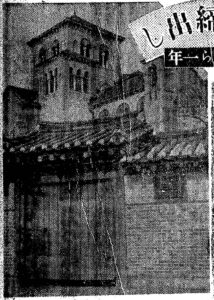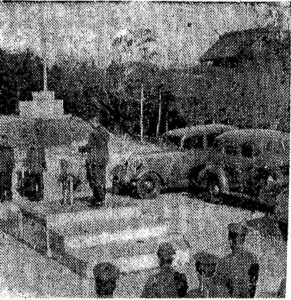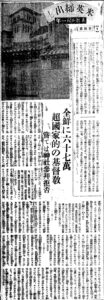During the final years of the Pacific War, as Imperial Japan faced defeat and mobilized every means available to sustain public morale, the colonial authorities in Korea intensified anti-American propaganda. One challenge they confronted was that, for decades, American missionaries had been deeply embedded in Korean society. They operated schools, hospitals, and churches, taught English, and often enjoyed widespread goodwill among Koreans. This posed a problem for the Imperial Japanese colonial regime, which needed to turn the Korean population decisively against the United States.
To address this, the colonial newspaper Keijo Nippō ran a serialized column in late 1944 titled 悪鬼米人の正体 (“The True Face of the Demonic Americans”). Beginning on August 6, 1944, this series published sensational atrocity stories depicting Americans, especially missionaries, as sadistic, inhuman abusers of Koreans. The narrative strategy was very clear: defame the missionaries to poison any lingering positive associations with America or Christianity.
I have not been able to fact-check these allegations. They may contain kernels of real incidents, heavy distortion, or be entirely fabricated, but I am posting this translation and transcription to build a trail for future researchers and historians. If anyone wishes to investigate further, the names, places, and stories contained in this article may serve as starting points.
The first installment focuses entirely on American missionaries, accusing them of cruelty toward Koreans:
-
Harold Walker allegedly confined his Korean cook in a dark storeroom without water for days after she revealed to students that there was a dead snake in vinegar he offered them.
-
Clyde Heismer allegedly branded a thirteen-year-old Korean boy’s cheeks with silver nitrate for picking up a fallen apple in a hospital orchard.
-
Seo Guk-tae allegedly drenched a blind Korean beggar woman and her child with buckets of cold water on Christmas morning and beat them with a cane.
-
Ok Seok-yeol allegedly intimidated an elderly pedestrian with his car, then struck and kicked him for not moving aside fast enough.
One linguistic detail stands out: Walker reportedly commanded the students to “eat the vinegar.” This phrasing is unnatural in both Japanese and English, but would make sense if the original words were in Korean, where 식초를 먹다 (to “eat vinegar”) can be idiomatic. This suggests that the quoted “English” speech in the article may have been based on Korean recollections or written in Korean first and then rendered literally into Japanese.
These articles represent a remarkable window into late-war colonial propaganda: the psychological battlefield, the anxieties of a collapsing empire, and the specific rhetorical tools used to manipulate Korean opinion.
[Translation]
Gyeongseong Ilbo (Keijo Nippo) August 6, 1944
The True Face of the Demonic Americans (1)
“Drink this ‘snake vinegar’ as God’s blessing”
A boy named Kim was branded on the cheek over a single apple
The enemy America intends to exterminate the Japanese from the face of the earth! With malicious and treacherous intent, America has provoked the war against us. As front line reports of the brutal acts of American soldiers have already shown, the Americans have mocked the corpses of our brave dead and even fashioned toys out of skulls. They have neither bushido nor humanity; cruelty and barbarism alone are America’s true nature. It is not only the American soldiers. In the past, many American missionaries came to Korea wearing clerical robes, preaching humanity and world peace, and thereby tricked the pure-hearted Korean people into traps with their schemes, while behind the scenes they carried out a merciless, inhuman trade in outrages that violated all morals. Truly these deeds, intolerable to both heaven and man, move those who hear of them to cries of anguish and fury. Here and now, we will expose the many evil deeds of the demonic Americans who profaned the Korean peninsula, allow you to clearly comprehend “the true face of the Americans,” and let your hatred against the Americans explode in a sincere resolve to strike the enemy down.
“The Koreans are all thieves. They are despicable animals. I would be ashamed even to give my doghouse to a Korean to live in.” Such were the offhand remarks about Koreans spoken by a certain Anglo-American missionary. The Korean people had until very recently been indulged into admiring the missionaries as “children of God,” believing that they alone would bring them happiness, and they blindly revered them as God’s own.
Harold Walker who imprisoned a cook over snake vinegar
In October 1937, an American missionary named Harold Walker, who set up residence in Andong-eup, North Gyeongsang Province and ran a Bible institute there with an air of “the world is mine,” employed a Korean woman in her forties, surnamed Yang (양, 梁), as a cook. Around the middle of October, Yang discovered that a filthy snake had fallen into and died in a vinegar jar that had been kept in a storage shed. When she immediately tried to throw the vinegar away, Walker's facial expression changed and, without saying a word, he sharply slapped her cheek. Then, as if he himself had handled something filthy, he carefully disinfected his hands with alcohol. Afterwards, he took the jar of snake vinegar to the female students at the Bible institute and, with shameless insincerity, said, “My dear sisters, allow me to give you some flavorful vinegar,” and attempted to make the girls drink the snake vinegar.
It was then that Ms. Yang felt anger for the first time. Even though she knew that she was going to be treated like a dog, she told the female students that there had been a dead snake in the vinegar. When Walker learned of this, he gathered the students and threatened them, saying, “How dare you refuse to eat the vinegar that your priest is giving you! You will soon receive God’s punishment.” In the end, he dragged Yang out, hurled her about, kicked her, and committed the utmost cruelties. Then, with stern resolve, he declared, “This woman put the snake into the vinegar. She is inhuman. She must be given divine punishment,” and kicked her into a dark storage compartment. She was called “a despicable animal”. He said that even if she did not eat or drink for a day or two it would be all right; she would not die. For several days he did not give her a single drop of water. What kind of inhuman behavior do those people display! This is the true face of those who pretend to be cultured and preach peace and equality.
Clyde Albert Heismer who branded a 13-year-old boy over an apple
Clyde Albert Heismer was a doctor at the Sunan Hospital run by the Seventh-Day Adventist Church in Sunan-myeon (순안면, 順安面), Pyongwon County, South Pyongan Province, and he was also a missionary. On August 10, 1925, the apples in the orchard in the hospital courtyard were in full ripeness, tempting the tastebuds of the children in the village. At that time, unable to endure the heat, a boy from Namchang-ri (남창리, 南昌里), surname Kim (age 13), was standing beneath an apple tree. Just then, a half-rotten apple fell. The boy Kim picked it up. Immediately, Heismer’s hairy arm seized the back of the boy’s neck, crying, “You thief!”
Saying only “I will kill you!” he tied the boy to the apple tree. The boy Kim strained his whole body in an attempt to explain himself. In the end, he begged for mercy. But Heismer only twisted his face into a sneer. “You trespassed in someone else’s orchard without permission, and on top of that you stole one of our beloved apples. Therefore you must receive divine punishment,” he said. He brought silver nitrate out from the hospital ward, thrust it before the eyes of the suffering boy tied to the tree, and said, “You do not know what this is, do you? I will teach you what it is.” Then he branded the character “thief” (盗) into the boy’s right cheek and the character “robber” (賊) into his left cheek.
The boy cried out from the pain and heat, whereupon Heismer burst into loud laughter as if it were amusing, stuffed a towel into the boy’s mouth, then whistled leisurely as he walked away. The scars on the boy’s cheeks bore the marks of Heismer’s cruelty, and did not disappear for several years.
Such was the missionary Heismer, who held the sacred office of a missionary. There is a saying, “Even demons have tears,” yet in his conduct we clearly see the true face of a missionary - no, an American - who did not shed even a single tear drop.
Seo Guk-tae who physically abused some beggars
On December 25, 1928 at around 7 a.m., when a biting north wind blew and the severe cold pierced the skin, a blind Korean female beggar, around forty years old, dressed in nothing but a tattered change of clothing and led by a child of about seven, came to the entrance of the luxurious residence in Jeonju City where an American missionary who went by the Korean name of Seo Guk-tae (서국태, 徐國泰) lived in opulence and indulgence. Despite being beggars in the last days of the year, they longed at least to greet the New Year with a single bowl of soup, and so they appealed for mercy to the man who daily preached charity and equality and spread the love of God.
What did he give them? A handful of silver coins? A bowl of warm soup for Christmas? Nothing of the sort. Instead, he poured a bucket of cold water on their heads. Shouting, “You still do not understand, do you? Bring a bucket full of cold water!” he again drenched the pair. This was the only gift he gave to the blind woman and her child, who sought mercy from the cold that bit their skin.
“How is that? Do you understand a little now? What do you think this place is, showing up brazenly in such filthy condition? Be gone at once!” he bellowed. In an instant, the freezing pain caused the beggar mother and child to scream in agony.
Seeing this, Seo struck the backs of the mother and child with his walking stick right at the entrance. Bright red blood dripped and stained the nearby snow crimson. This is it. This is their “charity” and “equality,” and the “mercy of Christ.”
Ok Seok-yeol who terrorized an elderly man with his automobile
In mid-May 1940, an American missionary who went by the Korean name of Ok Seok-yeol (옥석열, 玉錫烈) was driving his private automobile, with a certain Pastor Yutakayama accompanying him, en route to Yutakayama Church. As they drove, he noticed an elderly Korean man walking ahead; he increased his speed and closed in on the old man. As he approached, he suddenly sounded the horn loudly. Startled, the old man tried to get out of the way, but Ok deliberately drove the car further toward him. Terrified, the old man fell to the ground and screamed. At that moment, Ok brought his automobile to an abrupt stop, jumped out, struck the old man across the cheek, and kicked him in the hip. The old man sprang up and glared at Ok’s hairy face. “You old fool!” shouted Ok. Seeing that the man was an American missionary, the old man bowed respectfully and apologized.
“When a car comes, get down into that ditch! It was only because it was me that you were spared. But even if I ran you over, it might do some good since that would help me clean my car tires,” Ok said, as if it amused him, and boasted to Pastor Kaneyama that “they are like dogs or pigs; they will not understand unless they are made to suffer like this.”
[Transcription]
京城日報 1944年8月6日
悪鬼米人の正体 (1)
神の恵み飲め”蛇酢”
林檎一つで金少年の頬に烙印敵アメリカは日本人を地球上から抹殺するのだ―、と不逞不企図をもってわれに戦争を挑発して来た。敵米兵残虐な行為は既に前線から報道されている如く、わが勇士の戦死した屍を愚弄し頭蓋骨をもって玩具を作った。武士道もなければ人道もない、ただ残忍で野蛮性一本がアメリカの正体だ。アメリカ兵のみではない。嘗て半島にも数多の米人宣教師が法衣を纏って人道を説き、世界平和を説いて純粋なる半島人をまんまと謀略の手をもって陥穽に追いこみ、その裏では人倫を逸脱した非道悪虐の行商を白々しくも行って来た。まさに天人俱に許さざるこの行商は聞く人をして痛憤無念の叫びを発せしめるのである。半島を汚瀆した悪鬼米人どもの数々の悪業をいまここに暴いて”米人の正体”をはっきりと掴み敵を討つ真剣の構えに限りなき憎しみを爆発させよう。
”朝鮮人は全部泥棒だ。そして賤しい動物である。朝鮮人を住わせるには自分の犬小屋ももったいない”と放言した。これが米英宣教師の朝鮮人観であった。甘やかされた半島人は宣教師こそは”神の子”だ、彼等こそ我我を幸福にしてくれる唯一のものだと彼等を慕い彼等を神の子だと盲信してきたのはつい先頃までだった。昭和十二年十月慶北安東邑に居を構え”天下をわが物”顔に聖経学院を経営していた米人宣教師ハロルド・ウオルケルの家に四十代の半島人女梁某は飯焚として雇われた。半島人梁某(四〇)は十月の半ば頃だった。彼女は物置に保管してあった酢甕の中に汚い蛇が一匹落込んで死んでいるのを発見した。彼女はすぐさま酢を棄てようとした。ウオルケルは顔色を変え何んの文句もなく彼女の頬をピシャッリと打った。そして彼はさるがら汚い物でもいじったという態でアルコールで丁寧に手を消毒した。それから彼はその蛇酢を聖経学院の女生徒のところへ持って行き、さももったいらしく”親愛なる姉妹よ、味の良い酢を贈ろう”と白々しくも言って蛇酢を女生徒に飲ませようとした。
女中の梁は心中はじめて怒った。犬扱いにされるとは知りながらも彼女は女学生達に死んだ蛇が酢の中にあったこと教えてやった。これを知ったウオルケルは女学生を集め、”神父が贈った酢を食べないとは何事だ。今にお前達は神の罰を受けるであろう”と脅迫した。揚句梁女を連れ出し、擲る、蹴る、暴虐の限りを尽くし毅然と”酢の中に蛇を入れたのはコイツだ。人でなしだ。天罰を与えなければならない”と彼女を暗い物置の隔に蹴り込んだ。賤しい動物だ。一日二日位食わんでも飲まんでも大丈夫。死にやしないと彼は数日間彼女に水一滴をも与えなかったのである。何という非道な振る舞いをする奴等だろうか。表面文化人を装い、平和を、平等を唱える奴等の正体はこれだ。
クライド・アルバート・ハイスマーは平安南道平原郡順安面の安息教経営順安病院の医師であり、且つまた宣教師であった。大正十四年八月十日病院の庭内の林檎園のリンゴは今が盛りとばかりに実り、部落の子供達の味覚をそそっていた。折しも暑さに耐えかね、林檎の樹の下で南昌里の金某少年(一三)が佇んでいた。その時腐りかけた一の林檎が落ちた。金少年はこれを拾い上げた。とたんに”この盗賊めっ”とハイスマーの毛むくじゃらの腕が金少年の後首をギュッと締めた。”殺す”と唯一言い、彼は金少年を林檎の樹に縛りつけた。金少年は全身の力をしぼって弁解をした。最後にはあわれみを乞うた。然しハイスマーはニヤリと顔をゆがめるのみ”他人の果樹園に無断で入りしかも我々の好きなリンゴをかっぱらったのであるからお前は天罰を受けなければならないと彼は病室から硝酸銀を持ち出し、縛りつけられ苦しんで居る金少年の眼の前に突き出し、”これは何か知って居るか判らんだろう。どういうものかお前に知らせてやろう”と金少年の右頬に”盗”左頬に”賊”と焼き付けた。少年は痛さと熱さの余り喚いた、と見るやハイスマーはさも面白げにゲラゲラと笑いタオルで口を塞いで悠々と口笛を鳴らしながら立ち去って、金少年の頬の傷は彼ハイスマーの残虐の痕を止め数年間消えなかったのである。
これが聖なる宣教師の任にあるハイスマーの宣教師であった。”鬼の眼にも涙”というが我々は彼の振舞に一滴の涙をもたぬ宣教師、いや米人の実体をはっきり見るのである。
時は昭和三年十二月二十五日、朔風すさび酷寒肌を刺す午前七時頃ボロボロの更衣一枚をまとった七歳位の子供に手を引かれた四十歳前後の盲目の朝鮮人女乞食が、全州府に豪壮なる邸宅を構え贅沢三昧の生活を楽しんでいる米人宣教師徐国泰(鮮名)の玄関先に来て恵を乞うた。もう師走乞食の身ながらせめて一杯のお汁ででも楽しかるべき正月を迎えんものと、日頃博愛平等を説き、神の愛を説き散らす彼に哀みを乞うた。
このとき彼が与えたものは何であったか、一握りの銀銭であったか、はたまたクリスマスのための温かいスープであったか、決してそんなものではなくバケツの冷水を頭の上からザアザアとぶっかけたのである。”これ位ではまだ判らんだろう。バケツ一杯に冷水を持ってこい”と怒鳴るや、またも二人に浴びせかけた。これが寒冷に肌と寒さのため恵を乞うた盲人と少年に与えた唯一の贈物であった。
”どうだ、少しはハッキリしたか。此処を何処だと思ってそういうけがらわしい姿でノコノコ現れるのだ。さっさと帰れ”と怒鳴りまくった。忽ち凍りつく痛さに乞食親子は悲鳴をあげて苦しんだ。
これを見るや徐は玄関先のステッキで親子の背中をピシャリピシャリと打った。真っ赤な血がたらたらと流れ辺の雪を真っ赤に染めた。これだ。これが彼等の博愛平等であり、キリストの慈悲なのだ。
昭和十五年五月中旬、慶北安東郡の米人宣教師玉錫烈(鮮名)は自家用自動車を運転し豊山某牧師を随え豊山教会へ走っていた途中先方を歩いている朝鮮人の老人を見るや彼はスピードをあげ、その老人に接近して行った。接近したと見るや俄に強く警笛を鳴らした。老人は驚きの余り避けようとすると彼は尚もわざとその方向へ自動車を進めた。老人は恐怖の余りその場に倒れ悲鳴をあげた瞬間、車を急停止しては飛び降りるや老人の頬を打った。腰の辺を蹴った。老人はカバっとはね起き毛むくじゃらの玉の顔をにらみつけた。”この老ぼれ―”と彼はどなりつけた。老人は米人の宣教師とみるやうやうやしく頭を下げて謝った。
”車が来たらあの溝へ下って居れ。俺だから助かったの、お前なんかがしかれったって車のタイヤの掃除にはなるがね”玉はさも面白そうに金山牧師に”奴等は犬や豚みたいなものだからね、こんな目に会わさなければ判らん”とうそぶいた。
Source: National Library of Korea, Digital Newspaper Archive















